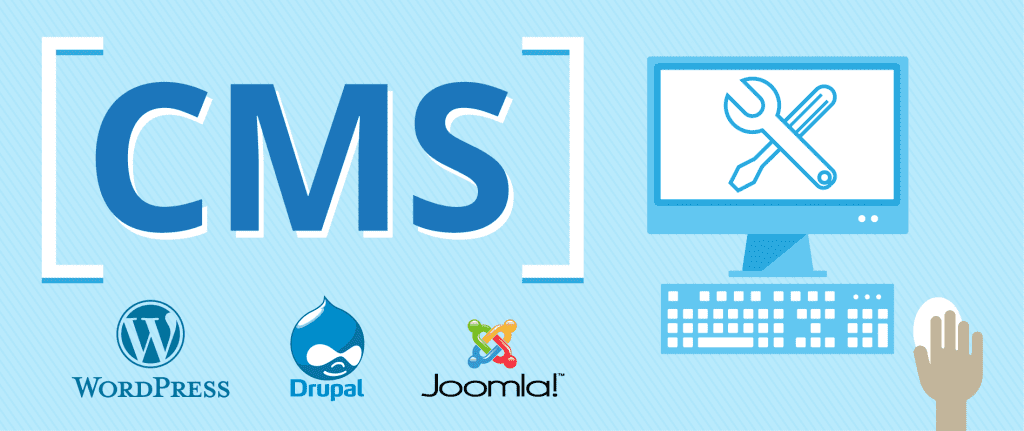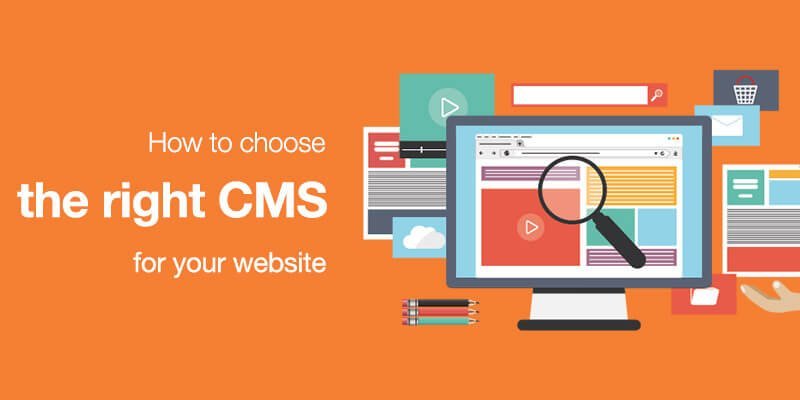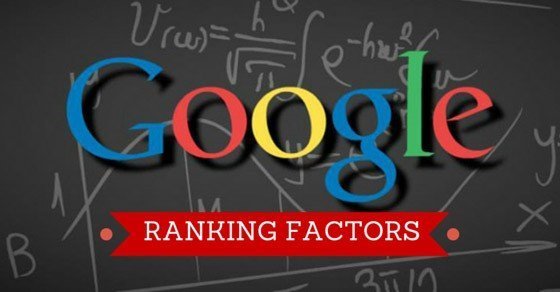Choosing the right web CMS is no snap. People regularly ask me what they should pay attention to during this important choice. A question that is more difficult than it seems, because there is no ready-made answer. Different systems respond to different needs. It is therefore especially important to find out where your specific needs lie now and in the future in order to make the right choice. In this article, I list a number of important technical factors to take with you in your decision.

Reduce your shortlist…
1. Choose a language
Due to the emergence of modern API-based system architectures – especially in the field of cloud solutions – the programming language has become less and less critical. Still, for integrations, custom solutions, extensions and hybrid set-ups, it is still useful to choose a CMS that is based on a language that your employees feel comfortable with.
Each language has its own advantages. You could, as it were, see the programming language as the building blocks of your solution. Not unimportant, but ultimately architecture is what really matters. Yet it can help reduce the shortlist if your developers are specialized in a particular language.
2. Page or content-centric
Although the exact definition is subject to discussion, you can generally state that the underlying content in a page-centric CMS is closely linked to the web page on which it is displayed. In other words: front and back end are linked to each other, which means that the content belongs to a specific page. This clear principle is ideal for blogs and for websites that are not much more than static online product brochures, where each piece of content is only displayed in one place.
In contrast, the content in a content-centric CMS is not connected to a specific web page. It can be displayed in different ways – for example on apps, portals, IoT devices or regional sites – in various ways and always adapted to the specific template. You could, as it were, see the programming language as the building blocks of your solution.
The big advantage of this is that the underlying content only needs to be adjusted in one place to display the update on all channels. For example, if you change the specifications of a specific product, you only have to adjust that in your back-end in one place. The CMS then carries out the change in all places where this product is shown.
Also, something to take into account in this context: matters such as dynamic content personalization, Single Page Applications (SPAs) and interactive touch-points such as chat and voice require a content-centric set-up.
3. Features for SEO and search
First of all, you want customers to be able to find your website. Then you want them to stay there. Since not all content writers are also SEO experts, it is useful if you make CMS search engine optimization easier, allowing you to add alt-text to images without knowledge of coding, to create readable URLs, to manage redirects and optimize HTML tags. Be aware that not every CMS offers these possibilities.
To make your content easier to find and improve your site search, it is also very useful if you can add metadata to specific pieces of content instead of the entire page. If you think this is important, it is advisable to look for a CMS with rich tagging that is standard able to feed search and make content easily understandable for advanced search applications. Looking into the future, for example, applications that use artificial intelligence (AI). How flexible should your digital world be?
4. Degree of personalization
If you operate a specific market niche, personalization may not be the highest priority for you. However, if your customer base is segmented, chances are that you want to show different homepage banners in different regions, for example, or even want to dynamically target your content throughout the experience.
Are you going for the highest level of personalization? Then you will have to open your content to AI to make one-on-one personalization possible. In all cases, keep in mind that the data for various aspects of personalization often comes from different systems (CRM, marketing automation, loyalty programs, etc.). The more sophisticated you pursue the degree of personalization, the more important it becomes that your CMS is able to communicate with all those systems.
5. The right set-up
A content-centric CMS consists of three essential components:
- the content repository (database)
- the editorial environment (backend)
- the presentation layer (frontend)
How you want to use these three components is up to you and depends on the situation. If front- and back-end are permanently connected, there is a linked CMS: perfect for smaller sites with few updates. By separating the editorial environment and the presentation layer from each other you get a somewhat more complex system, but it becomes easier to maintain multiple sites and implement updates without affecting your live environment.
If you are dealing with many different channels, such as apps and IoT devices (in-store displays, voice, etc.), a headless set-up is an obvious choice. A headless CMS has a separate content repository where the underlying content can be displayed on any frontend template (‘head’) – whether it is a third-party channel or a self-developed solution. The disadvantage is that in such a set-up it is difficult for marketers to adjust the templates themselves, add components or preview the presentation layer.
In this respect, a hybrid CMS offers the best of both worlds: it enables developers too – just like with a headless CMS – develop a presentation layer for every single channel and at the same time provides editors with a ‘decoupled’ presentation layer for the main website. Manage. For complex web environments (with many different channels) a hybrid CMS is therefore recommended.
6. Best of Breed (BOB) vs. Suite
This is a permanent discussion with convincing champions on both sides. Suites promise more centralized control from a single provider, but that control does come at the price of limited flexibility. If you want to experiment with a new tool or touchpoint, you will have to wait until this functionality is built into the suite. Best of Breed solutions require the deployment of developers to link them to other tools, platforms and data sources, but also ensure that you are not dependent on one provider.
For example, if you have invested in a CRM system that you are satisfied with or will soon try out a new e-commerce platform, a Best of Breed CMS gives you the freedom to choose. Since such a system works together with your existing technology infrastructure and you do not have to replace it completely, Best of Breeds often mean faster implementation.
If front- and back-end are permanently connected, there is a linked CMS.
From the customer experience perspective, marketing suites (with a built-in, native CMS) are often more focused on customer acquisition (and are very good at that), while Best of Breed CMS systems are more focused on the entire journey: integration with business process management (BPM), customer support, extranet, etc.
If you are mainly dealing with one-off purchases and customer acquisition is your main objective, then a marketing suite may be a good choice. If, on the other hand, you place much value on building a long-term relationship with your customer, consider whether you can not go for a Best of Breed solution.
7. Open Source or Proprietary
Proprietary solutions (i.e. products with a closed code base) have clear restrictions on what is and what is not possible with their tools. It is clear in advance which features and integrations you can expect. Those features have been extensively tested, which is a clear advantage. An open source solution gives you the opportunity to open the bonnet and to tinker the code to customize the product. Besides, you get access to shared solutions and components built by other members of the open source community.
Because of the size of these communities, there is usually a lot of documentation and training available about open source initiatives. Best of Breed solutions have open APIs available to connect to other solutions (regardless of the availability of code). The decision for or against open source is therefore largely dependent on the question of how much flexibility and customization you want to have, especially in the field of integrations. Where do you want to be in five years?
8. Cloud
It might well be that, like many other enterprise organizations, you are currently using a hybrid cloud architecture. A hybrid cloud architecture enables you to take advantage of the advantageous scalability of the public cloud, while hosting mission-critical applications on a more secure private cloud. In such a case you need a CMS solution that fits in well with such a set-up.
Software-as-a-Service solutions (SaaS) are managed by the CMS provider in the public cloud. These types of solutions are usually one-size-fits-all, where the provider takes care of the maintenance of the infrastructure and has control over the available features. This means a minimal effort from your own IT department and little preparatory work, but also a lack of customization, features, integrations and private cloud options.
With Platform-as-a-Service solutions (PaaS), the maintenance of the infrastructure is also with the provider, but its customization, features, and integrations are in the hands of the user. PaaS solutions require more preparatory work, but offer the flexibility to work in both public and private cloud environments. Some even offer the possibility to work in both ways in a hybrid way. Make sure you carefully examine your needs and preferences in this area beforehand.
9. APIs
The digital experience of your company is becoming increasingly important. Clients are outsourcing increasingly large parts of their buyer journey online, which means that your CMS, e-commerce platform, CRM, marketing automation, etc. must be able to work together very well. It also means that your content must be suitable for both web and apps, chat, voice, IoT and other emerging interfaces.
APIs are the connecting factor that makes all of this possible, because they structure the information in such a way that it can be shared and rendered independently of the platform or interface. As a company you have to deal with many different interaction points with your customer, then make sure that your CMS is set up for the use of APIs. This makes it a lot easier to connect your entire digital environment without annoying integrations, which is essential for providing a consistent, uninterrupted customer journey.
10. Ready for DXP
Now that digital is becoming increasingly important in the business objectives, there are also increasingly higher requirements for the underlying technology. Because the number of marketing tools used by companies is increasing rapidly, the need for a single central platform that links all these tools and prevents data silos from occurring is increasing.
This explains the rise of the Digital Experience Platform (DXP) that can orchestrate the entire customer journey from start to finish. Content management is only part of a DXP, but it is an essential part. That is why many DXP solutions come from classic CMS systems.
Now that digital is becoming increasingly important in the business objectives, there are also increasingly higher requirements for the underlying technology.
If front- and back-end are permanently connected, there is a linked CMS.
From the customer experience perspective, marketing suites (with a built-in, native CMS) are often more focused on customer acquisition (and are very good at that), while Best of Breed CMS systems are more focused on the entire journey: integration with business process management (BPM), customer support, extranet, etc.
A DXP ensures that all customer data collected and used by various systems is consistently used and exchanged throughout your digital landscape. In this way you prevent customers from being presented with different information in different places or, for example, having to re-enter data that they have already entered elsewhere. You can also follow the customer journey so much better and analyze the needs of the customer to present him with the most relevant content.
The ability to orchestrate data centrally is also essential for companies that want to integrate artificial intelligence into their experience. A DXP is an extraordinarily advanced system and may be a step too far for many companies at the moment. Nevertheless, especially for larger organizations with many different touchpoints, it is sensible to already take into account the possibility of integrating with a DXP at a later stage in the CMS selection.
The right choice for a CMS
Choosing a content platform is not a simple task. It has to satisfy several departments, and because it is a long-term investment, it has to grow with your digital needs. A good technology partner or analyst firms like Gartner, Forrester, Digital Clarity Group, Real Story Group or TIMAF (Erik Hartman) can help you find your way around the world of the CMS and help you find the solution that does not just suit you and meets current needs, but also supports the experience you want to build in the future.








